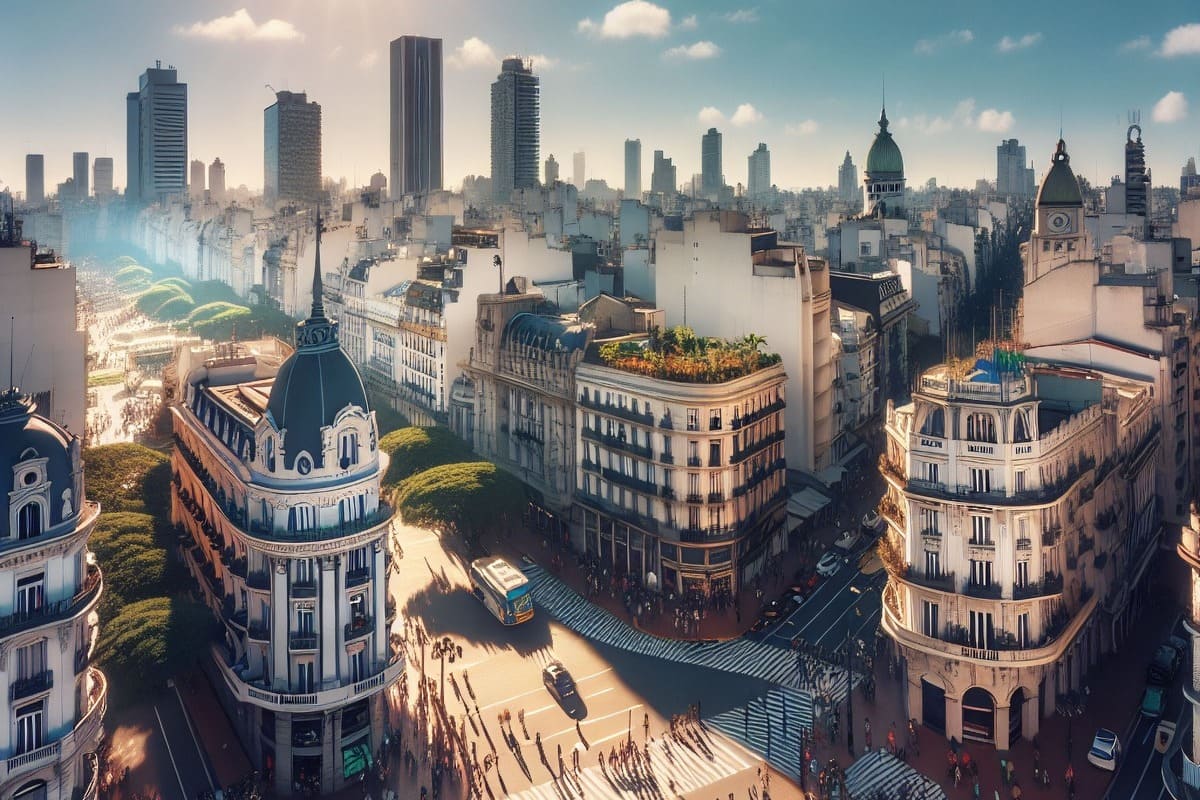Last Updated
Though undoubtedly popular, Latin America can be tricky to navigate as a tourist:
Yes, locals are welcoming and incredibly hospitable (in their vast majority).
Culturally, it’s nothing short of fascinating, and the strength of the dollar will really get you far.
However, on the downside, you may be subject to safety concerns you wouldn’t typically experience back home.


It’s not the case for all of them, but in some Latin American countries, this may include violent crime, endemic corruption, even in law enforcement, and widespread gang activity, particularly in large urban centers.
There are of course exceptions: according to the U.S. State Department, there are at least 4 LatAm cities that are less risky, making them ideal for first-time visitors.
Buenos Aires, Argentina


Starting with one of the most beautiful capitals in Latin America, Buenos Aires is widely known for its vibrant art scene, stately Belle époque architecture, evocative of Europe’s greatest manmade wonders, lush city parks, and vibrant nightlife.
The best part is, whether it’s strolling the colorful La Boca, chilling by the Japanese Garden, or going out for dinner at Puerto Madero, a lively dockside lined by redbrick buildings and upscale steakhouses, your chances of getting harassed, pickpocketed or robbed are surprisingly low.
While we would still advise you to not leave your hotel with valuable items that can get easily snatched in crowded spaces, or avoid deserted, poorly-lit areas at night, Buenos Aires is not the kind of the city you walk around constantly on edge.
In fact, when it comes to exploring, this North or South Buenos Aires guided bike tour is a great way to tick off the city’s main highlights while hearing unique city tales from a local.
As Washington officials themselves have ruled, U.S. citizens should simply exercise normal precaution during their time in Buenos Aires: it is one of a handful of destinations in the Global South to rank at Level 1––the same as Iceland, Finland, Switzerland and the like.
Merida, Mexico


A short two to three-hour flight from many U.S. hubs, Merida is the largest city and cultural heart of the Mexican state of Yucatan: it’s one of the best-preserved colonial cities in the country, and it’s developed a reputation over the years for also being the safest:
From a certificate issued by the Karolinska Institute of Sweden, proving its status as a ‘safe community’, to the U.S. State Department’s Level 1 classification, a list that includes countries like Iceland, Finland and the like, Merida has had consistently-high safety levels.
Violent crime and robberies occur at far lower rates in comparison to other mid-size cities in Mexico, and despite usual safety advice applying––as the official U.S. advice reads, take normal precautions––Americans are under no significantly-high risk in Merida.
Lucky for them, as it is host to a number of Mexico’s most culturally-significant landmarks, including the Cathedral of Merida, one of the oldest on this side of the pond, the well-preserved historic center, with its ornate facades, and Casa de Montejo, a 16th-century mansion.
For the budget travelers out there, you’ll be thrilled to learn Casa Montejo is free to visit, and it’s not something you want to miss: it’s been standing at its spot since the founding on Merida.
San Juan, Puerto Rico
San Juan is both a bustling city and historically-charged seaport, with the kind of lively social scene you’d expect from a well-frequented Caribbean resort zone and the vibrant culture you’d often associate with Latin America’s oldest, most traditional capitals.


The Spaniards originally settled it in the 16th century, and to this day, much of Old San Juan retains that colonial charm.
Its cobbled streets are lined by boutique shops and street food stalls, and even a monumental El Morro fortress could easily belong in Europe.
Elsewhere in the Isla Verde strip, the otherwise quaint cityscape gives way to casual beach bars, nightclubs, and luxurious casino hotels, so there’s something in San Juan for every type of traveler, whether it’s sun and fun or a cultural immersion you seek.
In addition, San Juan is considered to be generally safe.


As a U.S.-administered territory, Puerto Rico enjoys higher standards of living compared to independent Latin countries and lower crime rates; in other words, violence is not the daily reality facing most Puerto Ricans.
While you can definitely set out to discover San Juan’s winding streets on your own, we would recommend booking a walking tour––particularly one that includes food sampling––to optimize your visit and ensure you don’t fall for tourist traps.
This Old Town Foodie Walking Tour with Tastings costs $157, and it’s one of the top-rated activities in the city.
Santiago de Chile, Chile
The capital of Latin America’s longest, most unusually narrow state, Santiago de Chile, is a fast-developing metropolitan zone resting in the bottom of a valley surrounded by the towering, snow-capped Andes mountains.


Though it does have a beautiful colonial center and is host to a number of Spanish-built landmarks, like the 18th-century Metropolitan Cathedral, it’s a city most easily recognized for its thriving business districts, innovative skyscrapers, and disruptive modernism.
Walking around Downtown Santiago, with its cooler weather and gigantic, glass-and-steel high-rises looming over busy thoroughfares, one might be led to believe they’re in Chicago or Toronto instead––except it’s Spanish that’s widely spoken in the streets.
Regarding safety, while we wouldn’t advise you to leave your phone on a tabletop as you dine on an outdoor patio or wear valuables that may attract pickpockets, violent crime is less of an issue in Santiago compared to other Latin American metropolises like São Paulo or Medellin.
For an even safer experience, we would recommend you stay close to Downtown, where there’s a plethora of foreigner-friendly hotels to pick from and wide plazas that are well-surveilled: this fall, Mercure Santiago Centro is an affordable accommodation option costing $76 per night.
As the State Department reiterates, simply exercise increased caution when visiting, as you would in any big city.
↓ Elevate Your Travel↓
Sign Up Now For Travel Off Path Premium! No ads, VIP Content, Personal Travel Concierge, Huge Savings, Daily Deals, Members Forum & More!


✈️Join Our Travel Off Path Community Forum: Where travelers unite, ask questions, share experiences and even find like-minded travel buddies!
SUBSCRIBE TO OUR LATEST POSTS
Enter your email address to subscribe to Travel Off Path’s latest breaking travel news, straight to your inbox.
This article originally appeared on TravelOffPath.com
Opinions expressed here are the author’s alone, not those of any bank, credit card issuer, hotel, airline, or other entity. This content has not been reviewed, approved or otherwise endorsed by any of the entities included within the post.

